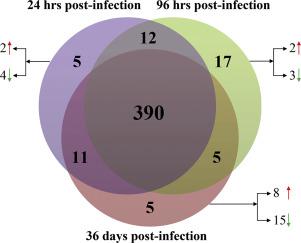Journal of Proteomics ( IF 3.3 ) Pub Date : 2020-11-17 , DOI: 10.1016/j.jprot.2020.104049 Wen-Bin Zheng 1 , Yang Zou 2 , Jun-Jun He 2 , Guo-Hua Liu 3 , Min-Hua Hu 4 , Xing-Quan Zhu 5

|
Toxocara canis causes ocular larva migrans and visceral larva migrans in humans. Knowledge about the molecular mechanism of T. canis-hosts interaction is limited. The proteomic alterations in the plasma of Beagle dogs induced by T. canis infection were studied by the quantitative mass spectrometry-based data-independent acquisition (DIA). 418, 414 and 411 plasma proteins were identified at 24 h post-infection (hpi), 96 hpi and 36 days post-infection (dpi), including 6, 5 and 23 proteins with differential abundance, respectively. At 24 hpi, the altered proteins, retinoic acid receptor responder protein 2 (RARRES2), WD repeat-containing protein 1 (WDR1), moesin and filamin-A, may participate in pro-inflammatory reaction or promote larvae migration. At 96 hpi, the altered protein C and fibroleukin may maintain the stability of the coagulation system to protect the lung. At 36 dpi, the alterations of C-reactive protein (CRP), ficolin (FCN), complement factor H-related protein 5 (CFHR5) and other complements can affect the three traditional complement system, including the classic pathway, lectin pathway and alternative pathway. These proteins may play important roles in the interaction between T. canis and its definitive hosts. Further study on these altered proteins triggered by T. canis infection may discovery novel therapeutic or diagnostic targets for toxocariasis.
Significance of the study
Toxocara canis is one of the globally distributed soil-transmitted helminths, which causes ocular larva migrans and visceral larva migrans in humans and a wide range of warm-blooded animals. T. canis adapts to different microenvironments by resisting and adjusting various biological processes of the hosts. Knowledge about the molecular mechanism of T. canis-hosts interaction is limited. Plasma proteins are good marker for monitoring the occurrence and development of diseases. The proteomic alterations in the plasma of Beagle dogs induced by T. canis infection were studied by the quantitative mass spectrometry-based data-independent acquisition (DIA) in this study. A total of 418, 414 and 411 plasma proteins were identified at 24 h post-infection (hpi), 96 hpi and 36 days post-infection, respectively. Ten protein with differential abundances were validated by using parallel reaction monitoring (PRM). Collectively, our deep proteomic analysis of plasma revealed that proteins alterations were affected by disease development, and proteomic analysis is an ideal method for quantifying changes in circulating factors on a global scale in response to pathophysiological perturbations such as T. canis infection.
中文翻译:

犬弓形虫感染引起的比格犬血浆蛋白质组学改变
犬弓形虫在人体内引起眼部幼虫偏头痛和内脏幼虫偏头痛。关于犬圆弧菌-宿主相互作用的分子机制的知识是有限的。犬T.canis诱导的比格犬血浆蛋白质组学改变。通过基于定量质谱的数据独立采集(DIA)研究感染。在感染后24 h,96 hpi和dpi 36 dpi(dpi)鉴定出418、414和411种血浆蛋白,分别包括6、5和23种差异丰度的蛋白。在24 hpi时,改变的蛋白,视黄酸受体应答蛋白2(RARRES2),含WD重复序列的蛋白1(WDR1),肌球蛋白和纤维蛋白A可能参与促炎反应或促进幼虫迁移。在96 hpi时,改变的C蛋白和纤维白蛋白可以维持凝血系统的稳定性以保护肺部。在36 dpi时,C反应蛋白(CRP),丝胶蛋白(FCN),补体因子H相关蛋白5(CFHR5)和其他补体的改变会影响三种传统补体系统,包括经典途径,凝集素途径和替代途径。这些蛋白质可能在T. canis及其确定的寄主。进一步研究由犬圆弧菌感染触发的这些改变的蛋白质可能会发现弓形虫病的新型治疗或诊断靶标。
学习的重点
弓形虫是全球传播的土壤传播的蠕虫之一,可导致人类和多种温血动物的眼部幼虫和内脏幼虫迁移。犬圆弧菌通过抵抗和调节宿主的各种生物过程来适应不同的微环境。关于犬圆弧菌-宿主相互作用的分子机制的知识是有限的。血浆蛋白是监测疾病发生和发展的良好标记。犬T.canis诱导的比格犬血浆蛋白质组学改变。在这项研究中,通过基于定量质谱的数据独立采集(DIA)研究了感染。分别在感染后24 h(hpi),96 hpi和36天后鉴定出总共418、414和411种血浆蛋白。通过使用平行反应监测(PRM)验证了十种具有不同丰度的蛋白质。总的来说,我们对血浆的深层蛋白质组学分析表明,蛋白质变化受疾病发展的影响,蛋白质组学分析是一种定量方法,可在全球范围内量化对犬病原体感染等病理生理扰动的循环因子变化。


























 京公网安备 11010802027423号
京公网安备 11010802027423号